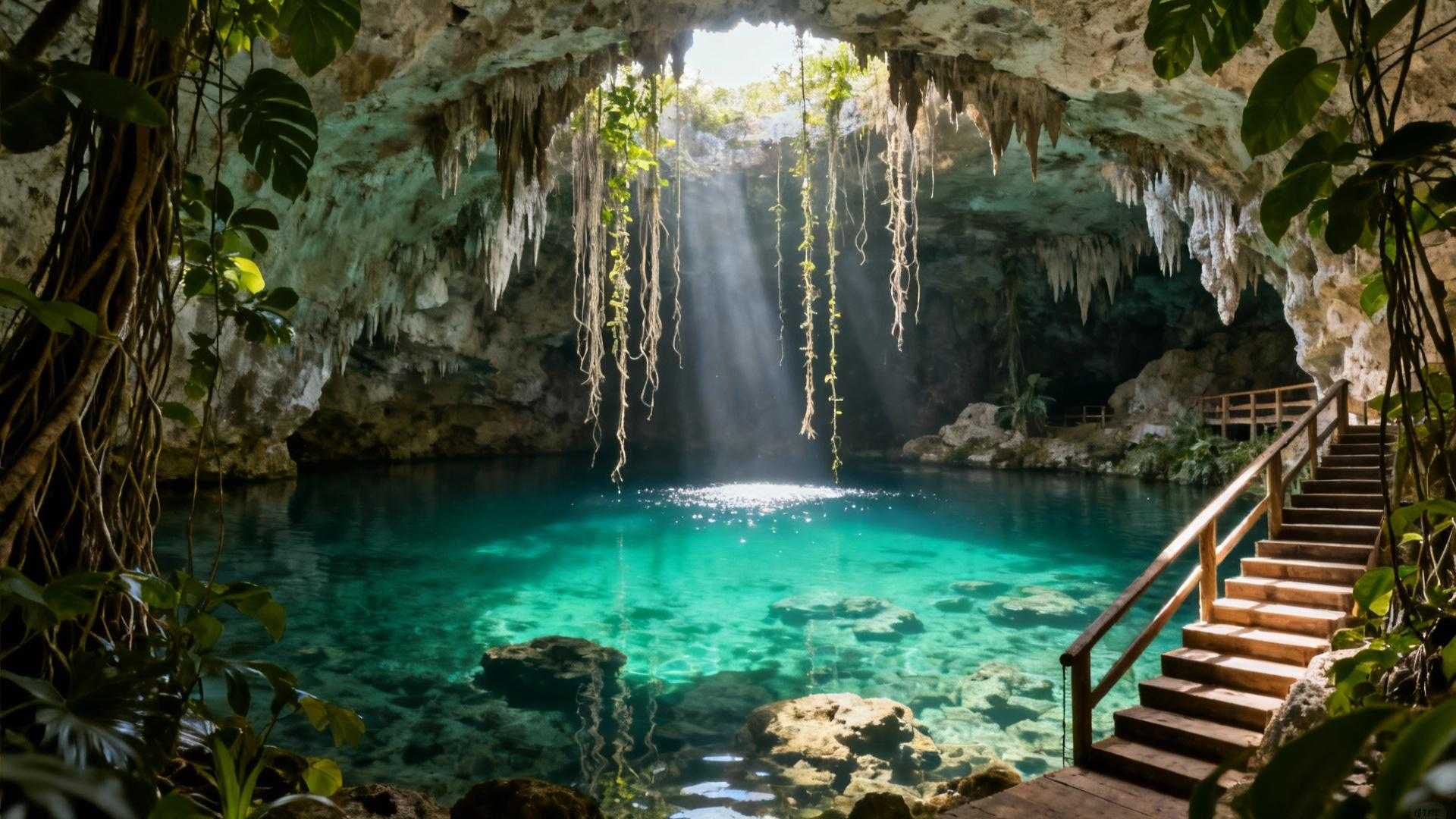I spent three days trapped in my $180-per-night Cancún resort, fighting for beach chairs at 6am and dodging spring breakers in crowded pools. At 52, I’d imagined something different from Mexican paradise. Then my taxi driver mentioned a place called Cenote Ik Kil—a sacred Maya water temple 90 minutes inland. I ditched my prepaid resort breakfast the next morning and never looked back.
What I discovered changed how I understand swimming forever. These aren’t pools. They’re 40-meter-deep turquoise cathedrals carved into limestone by a meteor impact 66 million years ago, where Maya royalty once performed sacred ceremonies and local shamans still bless visitors before they descend.
The entire experience cost me $10 entrance fee.
The blessing ceremony that transforms every swim
Why Maya shamans perform water purification rituals
Before I could approach the water at Cenote Ik Kil, a local Maya elder stopped me. No chemical sunscreen—it destroys the delicate ecosystem that’s survived millennia. She performed a brief cleansing ritual, burning copal incense and speaking Yucatec Maya prayers. This wasn’t tourist theater. The 6,000 cenotes scattered across Yucatán remain sacred portals to Xibalba, the Maya underworld, where communities still maintain spiritual protocols their ancestors established.
The moment you realize these aren’t swimming holes
I descended 130 wooden steps through hanging vines into a cylindrical opening 60 meters wide. Sunlight pierced the turquoise water in cathedral beams. Small catfish circled my legs in water so clear I could see limestone formations 40 meters down. Above me, tree roots dangled from the surface like natural curtains. I’d paid 94% less than my Cancún resort for an experience that felt like swimming inside a living temple.
What $180 resort chaos actually gets you versus $10 sacred solitude
The crowd mathematics that change everything
My Cancún resort hosted 4,000 guests fighting for the same beach stretch, the same buffet lines, the same pool loungers. At Cenote Ik Kil during October’s shoulder season, I counted maybe 50 visitors throughout the entire day. At smaller cenotes like Cenote Zací near Valladolid—where locals actively protect their sacred waters from Instagram overtourism—I swam completely alone for an hour, surrounded only by limestone walls and bird songs echoing off ancient stone.
Why freshwater clarity beats ocean swimming
Ocean water at Cancún beaches carries suspended sand, seaweed, and the churning of thousands of swimmers. Cenote water maintains 72-78°F year-round, filtered through limestone for thousands of years until it achieves crystalline transparency. I could photograph fish 15 meters below me without zooming. No salt burning my eyes. No waves. No jellyfish. Just pure geological perfection that rivals Costa Rica’s coral cathedrals for underwater drama.
The 6,000 cenotes locals desperately want to protect
Why Maya communities limit access to sacred waters
Most tourists visit the same five famous cenotes. Meanwhile, hundreds remain known only to locals who guard their locations fiercely. Near Cuzamá, I hired a guide who transported me via horse-drawn cart along abandoned rail tracks to three hidden cenotes. Each required a new blessing ceremony. Each felt like discovering a secret the jungle had concealed for centuries. These communities aren’t being difficult—they’re protecting spiritual heritage from the 4 million annual tourists who’ve already overwhelmed Cancún’s beaches.
The underwater caves mass tourism will destroy
Some cenotes connect to underground river systems spanning 350 kilometers. Advanced divers explore passages that ancient Maya once used for sacred rituals, discovering pottery and ceremonial offerings still preserved in oxygen-free water. But chemical sunscreens and touching hands damage formations that took thousands of years to create. This is why entrance rules exist—and why respectful travelers follow local protocols without complaint.
What October’s shoulder season delivers
The visibility advantage nobody mentions
Visit between October and November, after the rainy season clears but before December’s holiday crowds arrive. Water visibility reaches its annual peak—30+ meters of clarity—while Cancún resort prices drop 20-30%. I found entire cenotes to myself at 2pm on a Wednesday, experiencing the same pristine conditions that cost triple during winter high season.
How to find the cenotes locals actually visit
Skip the tour buses heading to Xcaret’s manufactured attractions. Drive to Valladolid and ask at family-run restaurants which cenotes locals swim in. They’ll direct you to places like Cenote Suytun or Oxman, where entrance fees stay under $5 and you’ll share the water with Mexican families rather than cruise ship excursions. Bring cash, respect the blessing ceremonies, and leave manufactured tourism chaos behind forever.
Questions about sacred cenote swimming
Do all cenotes require blessing ceremonies before swimming?
Not all, but many cenotes maintained by Maya communities do perform copal incense cleansing rituals. These brief ceremonies honor the sacred nature of cenote waters and remind visitors they’re entering spiritual spaces, not theme parks. Respectful travelers welcome this cultural education rather than viewing it as tourist entertainment.
Can beginners safely swim in 40-meter-deep cenotes?
Absolutely. Most cenotes provide life jackets, and you don’t need to dive to enjoy them. The crystal-clear water creates the illusion of swimming in a cathedral-like space. Depths vary—some cenotes are only 3-5 meters deep, while others like Ik Kil reach 40 meters. All offer safe surface swimming with incredible visibility.
What’s the real cost comparison between cenotes and Cancún resorts?
Cancún all-inclusive resorts average $150-250 per night during peak season. Individual cenote entrance fees range from $1.50 to $10 USD. Even adding a rental car ($30/day) and modest hotel in Valladolid ($40-60/night), you’ll spend 60-70% less while experiencing authentic Maya culture instead of manufactured resort entertainment.
